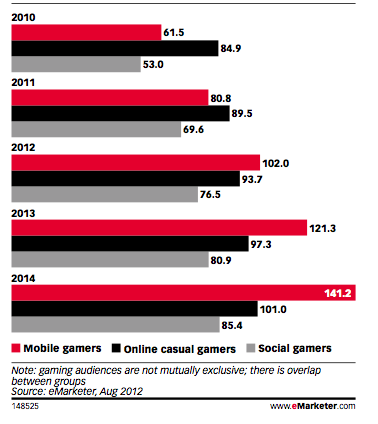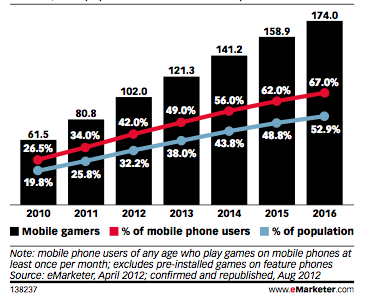By Liam Dowd - June 26th, 2013
Gaming and social media go hand-in-hand, but how are corporations using this channel to connect with their brand advocates?
Gaming has been a major component of online marketing for several years. Enter the smartphone and tablet PC, a whole new strata of gaming opened up that businesses could use to connect with their customers. And their customers love to play games: according to ComScore, 645 million people now play games online, or over a third of the entire population of the Internet.

For brands this user base is massive and is likely to rapidly increase, as gaming across all platforms becomes even more popular, with massive growth with mobile gaming already being seen. According to eMarketer, over 50% of the US population will play games on their mobile devices by 2015, and with the spending power of these gamers being substantial, gamification is now a highly lucrative channel.
The clear challenge for businesses is to match their game development to the commercial drive that gamers feel when playing. According to MediaBrix game-based ads are now outperforming traditional online ad.
Research from MediaBrix concludes: “According to MediaMind, standard banners ads generate a click-through rate (CTR) of .10%, rich media banner ads generate a CTR of .12% and rich media expandable banner ads generate a CTR of .19%. Additionally, according to AdParlor, Facebook ads see CTRs ranging from .03% to .11%, respectively.
“On average, social and mobile gaming ads see an average CTR of 3% and social and mobile gaming value exchange ads—where the users receive a reward for viewing the full ad—see an average CTR of 11%, outperforming all other types of ads. Thus, it outperforms standard banner, rich media, expandable video and Facebook ads.”
“The reason why gamification works so well is related directly to the fact that young consumers are growing up in a world where video games are a part of mainstream culture,” noted Gabe Zichermann, Chair of the Gamification Summit and CEO of dopamine, in an interview with Retail TouchPoints. “However, even people that didn’t grow up around video games appreciate all the values that gamification has to offer in terms of feedback, sociability and all the other mechanics gamification brings.”
However, an analyst from Gartner writing for Forbes warned: “We predict that by 2014, 80% of current gamified applications will fail to meet business objectives, primarily due to poor design. This design includes defining business objectives as well as application definition, deployment and adoption. In the longer term, as design practices improve and organizations focus on defining clear business objectives, gamification will have a significant business impact and become an important means for organizations to engage audiences at a deeper level.”
Moves to mobile
Who is playing games online and on their mobile devices is also important to understand if marketing messages are to properly exploit the propensity to play games. A Newzoo survey in 2011 revealed that understanding how gaming themes attract gamers is vital to understand. For instance, young girls will gravitate towards creative games.
Adult women prefer games that mentally stimulates them with puzzle games being the most popular, with boys being more interested in adversarial games that enables them to achieve highest scores. More interesting though, is the crossover that is also seen. Here, around 20% of young females play what are designed as male-orientated games.
In their report eMarketer stated: “Mobile gaming is undergoing significant growth as smartphones and tablets gain sophistication and users become accustomed to transporting the gaming experience across screens. The US mobile gaming audience grew by 31.4% in 2011 and gains will continue in the double digits through 2015. By 2016, growth will taper to 9.5%, at which point 52.9% of the US population will be mobile gamers.”

What is clear for brands is that gamification can be a potent part of their marketing mix, but this component has to be handled carefully and the rules of engagement adhered to.
Social gaming
Online gaming is still dominant, but casual social gaming continues to see growth. It’s forecast that by 2014, over 80% of gaming will have a social component. And this huge rise is very lucrative. It is expected that gaming revenue could top $371 million by next year. The vast majority of this spend will continue to be on virtual goods, but as monetisation platforms continue to develop, the revenue gained from non-virtual goods will see meteoric rise.
“Social and mobile gaming offers a new creative palette,” commented MediaBrix. “According to a 2012 Harris Interactive study, the majority of Facebook gamers and smartphone owners prefer immersive, interactive ads to standard banner ads. Similarly, the majority of Facebook gamers and smartphone owners prefer user-initiated video ads or those shown during natural breaks in games to pre-roll video ads. In order to keep with consumer preferences, marketers must reach and engage them with new creative ad units, including user-initiated video ads, value exchange, social sharing and other interactive features.”
“We’re just at the start of what’s possible with gamified behaviour, especially as it relates to product consideration and purchases in retail,” said Todd Parsons, CEO of Aditive. “Consumer behaviours, the ways they share information via social media, and the devices they use to connect with brands and friends in places where retail is possible are just beginning to come of age. If the last couple of years were a toehold towards being established, this year will be a big leg up.”
What is clear is that gamification can be highly effective if handled correctly. Dopamine’s Gabe Zichermann identifies three clear traits that gamification must have: Feedback: When employees do well, an employer should reward those efforts. Similarly, when a consumer commits to purchasing a retailer’s products, the retailer should reward those consumers for their loyalty. Friends: By involving friends and creating camaraderie, users have a personal investment and motivation for participating in games and challenges. And fun: Games are fun. Most, if not all, people, including consumers and employees, like to participate in things that are fun.
Deloitte concluded: “Gamification can provide a reason for a customer to visit a website or a store more often. It could give employees a new way to obtain the feedback they desire on job performance. It could connect customers in a way that makes them feel rewarded and respected for their opinions and support of your business or product.” Gamification is maturing and taking a vital role in brand promotion. Social media is the spiritual home of gamification. It’s up to brands to understand how this channel can be integrated into their business goals.
